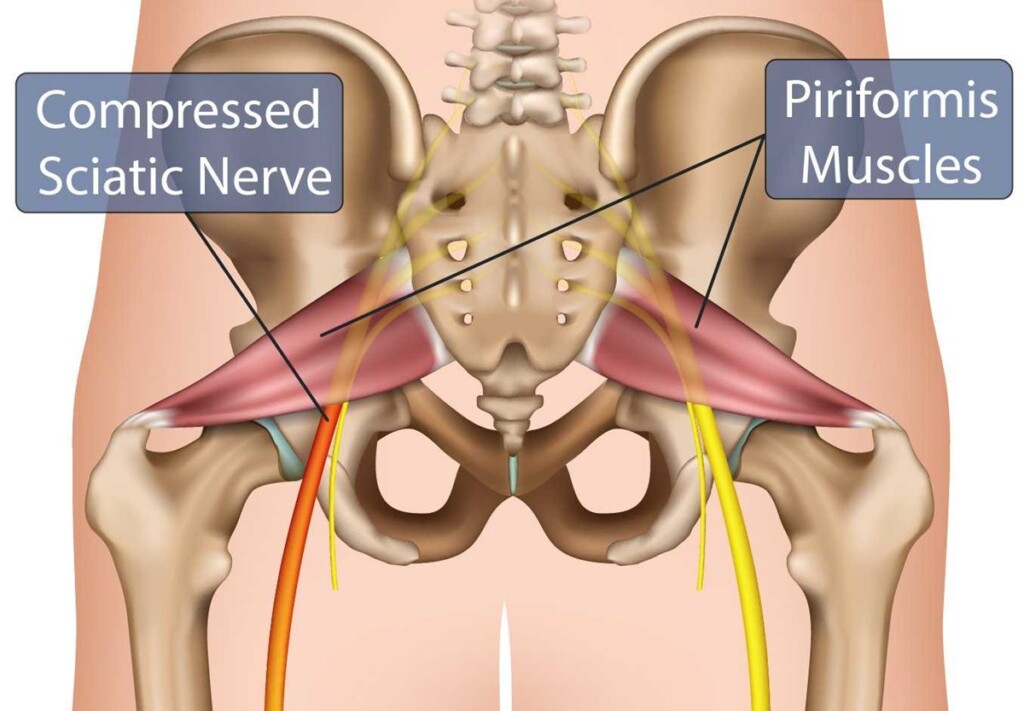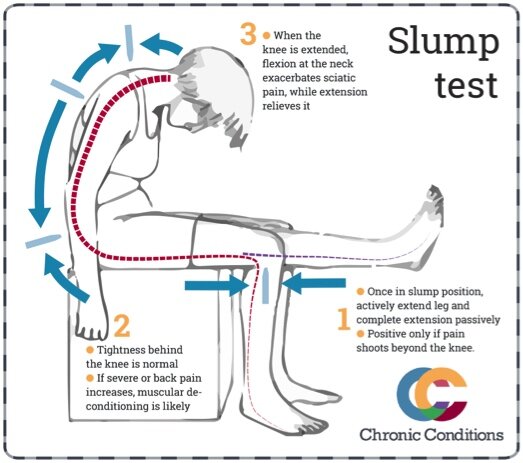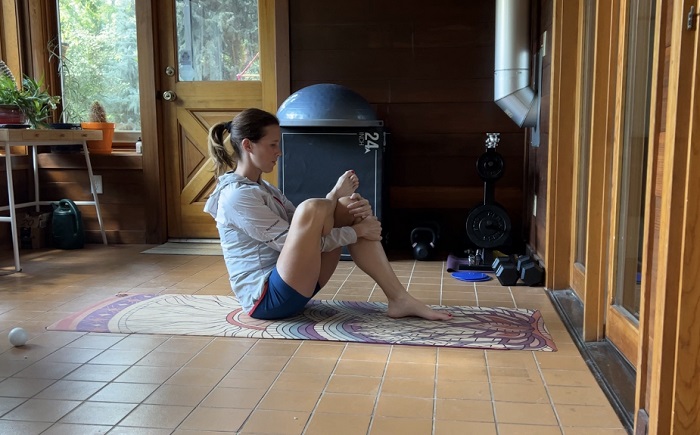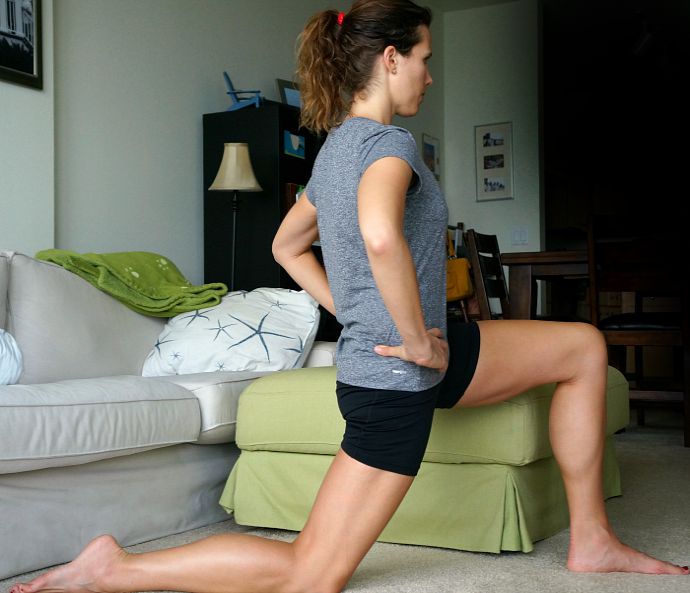While high impact activities, like running, place more impact on the spine and surrounding nerves, does it cause sciatica? Will continuing to run make it worse? We’re going to dive in to what you need to know.
If you’ve ever experienced any kind of nerve pain, you’re familiar with how uncomfortable and even debilitating it can be. Depending on where it is and what is causing it just sitting still can feel horrible, let alone contemplating a run.
You may have heard your fellow runner friends talking about it from time to time, especially if they’re experiencing discomfort during or shortly after a run. Often we aren’t sure what this pain in the butt is, but meet your sciatic nerve. Something so small that can trigger so much discomfort.
What is sciatica, how do you know you have it, what causes it, how can you prevent or relieve it? And the all important question, can you still run while experiencing it? We’ll answer all of those questions and probably a few more with the help of a corrective exercise specialist.
What is Sciatica?
To put it simply, sciatica is pain that travels along the path of the sciatic nerve. Ok, but what exactly does that mean?
The sciatic nerve extends from the lower back and runs down the back of both legs. It’s job is to help us stand, walk, and run. Basically it helps us move and feel things like touch and other sensations.
It’s actually the LONGEST nerve in the body, which is why it can do so much.
What Does Sciatic Nerve Pain Feel Like?
If you’re experiencing sciatic nerve pain, you could have a variety of symptoms. It could feel like any or a combination of the following:
- Mild tingling
- Dull ache
- Burning sensation
- Numbness
- Pain that gets worse after sitting for a long time
A lot of people describe it as a jolt of lightning that shoots down the back of the leg. It usually only happens in one leg at a time. You may also feel any of these sensations in your lower back, hip, and buttocks.
What are Causes of Sciatica?
There are a number of things that can cause sciatica. The most common causes of sciatica come from bone or soft tissue pressing against the sciatic nerve, often in the lumbar spine, sacro-illiac junction (where the spine and pelvis meet), or within the deep musculature of the gluteals.
Knowing where this occurs makes it quite obvious why the pain is located in the areas it is.

So what causes this pressure on the nerve?
There are a surprising number of potential causes:
- Overuse injury (the most likely reason you’re here)
- Heavy lifting or twisting
- Pregnancy
- Bone spur
- Herniated disc
Age can be a contributing factor. As we get older we can develop age-related spinal degeneration. Hopefully most of us aren’t there yet though, especially if you’ve been continuing to run and lift!
Another cause could be various injuries or inflammation in our lower back or the sacro-illiac joints. We could also have an angry, i.e. inflamed or tight piriformis muscle.
Do You Have Sciatica?
So how do you know if you have sciatica or something else that has similar symptoms?
Other issues that it could be include, but are not limited to, piriformis syndrome, issues in your spinal joints like arthritis, or sacroiliac joint dysfunction.
The first clue is just how it feels and where the pain and discomfort is located. As we’ve discussed, sciatic nerve pain is unique in that it tends to travel down the back of the leg from the lumbar spine or mid-glute to the hamstring. It can even stretch into the calf or foot. The burning sensation or the sudden jolt are very common symptoms.
While it may seem like it’s easy to self-diagnosis, it’s always a good idea to get an official diagnosis from a doctor or physical therapist. The good news is you won’t need x-rays or other tests unless it’s not actually sciatica.
There are some non-invasive tests your doctor may do or that you can even try yourself at home before you head in for an appointment.
It’s important to know that this is usually inflammation and NOT something that has to be long term.
Sciatica Vs Pirformis Syndrome
It’s actually not uncommon for runners to deal with piriformis syndrome, which is why I’ve written extensively about that previously.
Since the sciatic nerve runs right through the piriformis, if you are experiencing tightness or muscle spasms there it could be putting pressure on the nerve. This is when you go from having a pain in the butt to it shooting all the way down your leg.
That means we usually need to address both at the same time.
Sciatica Test At Home
Generally at the physical therapist or chiropractor, you will lie flat on your back on either the floor or your bed with your legs out straight. This position, particularly on the floor or a more firm surface, straightens the sciatic nerve and ensures you have good posture.
The next step is to lift the leg where you’re feeling the pain symptoms as high as you can go without straining or stretching excessively and without bending your knee if at all possible. If the pain you’ve been experiencing ramps up, you may have sciatic pain.
BUT at home, it’s often a lot easier to do what is called the slump test. Both are ways to check things out, this one just feels easier to some to quickly pin point.

How to Relieve Sciatica Symptoms
If you’re experiencing sciatica symptoms, you can find relief and you can probably do it on your own at home. However, if it’s severe, it’s still recommended you see a doctor, physical therapist, or a corrective exercise specialist.
Isabella Diener, MS and CPT and a corrective and pre-/postnatal exercise trainer, has a few favorite mobility exercises she recommends to clients sealing with sciatica pain. She also has a few words of advice.
“It’s important to keep the core, hips and posterior chain both mobile and strong to prevent sciatica. Daily stretching for the glutes, hip flexors, and lower back should bring some more immediate relief, but for long term changes, be sure to continuously strengthen the abdominals and all glute muscles.”
Windshield Wipers
While also a core exercise, Diener says these are great for decompressing the lumbar vertebrae and the sacro-illiac joints.
To do these, lie flat on the floor and bring your knees up to a 90-degree angle above your hips. Put your arms straight out to the side.
Keeping your knees and feet together and your shoulders on the mat, rotate your hips from left to right and back. Do this nice and slow.
Figure-Four Stretch
“The figure-four stretch is great to help stretch out the deep gluteals, which may be pushing on the sciatic nerve,” says Diener.

To do the Figure-Four stretch, sit on a bench or chair and bring your left foot to your right knee. With good posture and a flat back, bend forward from the hips until you feel a slight stretch in your left glute. Hold for 30 seconds. Repeat on the right side.
You can also do this lying flat on a bench or the floor. Instead of bending your upper body though, you’ll use your arms to pull your thigh toward your torso.
Runner’s Lunge
Tight hip flexors can also contribute to a tighter lumbar spine curve. The runner’s lunge is a great way to stretch them out.
To do the runner’s lunge, kneel down with your left knee on the ground and your right knee bent at a 90-degree angle in front of you. You want the knee over the ankle in the starting position.

While in this position with a nice tall posture, tuck your pelvis. You might already feel a stretch simply by doing this subtle movement. To advance, slowly lean into your right knee to deepen the stretch in your left hip flexor. You can also take your left arm up overhead and lean away from the left hip flexor.
Hold for 30 seconds and repeat on the right side.
Now let’s keep building on these:
Can You Run with Sciatica?
If you’re experiencing sciatic nerve pain, it is possible to still run. It really depends on your personal experience with the pain.
The reality is the sciatic nerve plays a really important role in our ability to run. Continuing to run and doing other high-impact exercises or other things that use the same muscles may result in a worsening of the pain or just a delay in it being resolved.
However, if your pain isn’t severe and you’re comfortable running no one will stop you. There are some things that you can do to help lessen and resolve the pain ahead of and after a run.
- Warm up! You know I never miss an opportunity to encourage runners to complete a dynamic warm up before a run.
- Take time for a cooldown after your run. Walk for 10-15 minutes before taking time to do some post run stretches. Focus on your hip flexors, low back, and glutes.
- Enjoy a hot bath with epsom salts for recovery.
- Do some low-intensity yoga focused on mobility.
If you’re running and the pain increases at any point, stop running and focus on tackling the issue before returning to running.
“You should always consult a physical therapist, corrective exercise trainer, or orthopedist if you experience sciatica on a weekly or daily basis,” says Diener.
“These professionals can help pinpoint the potential cause of the sciatica, and give you instructions to start treating it. For example, they may identify any injuries to the spine, which need to be addressed before resuming exercise.
They may test for any muscular deficiencies, which may cause or exacerbate the pain, and provide exercises to strengthen where needed. Finally, they may give you advice on how to correct your running form if that is contributing to your sciatica.”
Can you run? Yes.
But like with many injuries is that the best long term course of action? A few days of cross training, working through the PT exercises and yes even going to the chiropractor to try and lessen pressure on the nerve will hopefully get you moving again pain free sooner.
Other ways to connect with Amanda
Instagram Daily Fun: RunToTheFinish
Facebook Community Chatter: RunToTheFinish
Sign Up to Receive a Weekly Newsletter with Top Running Tips and Laughs

